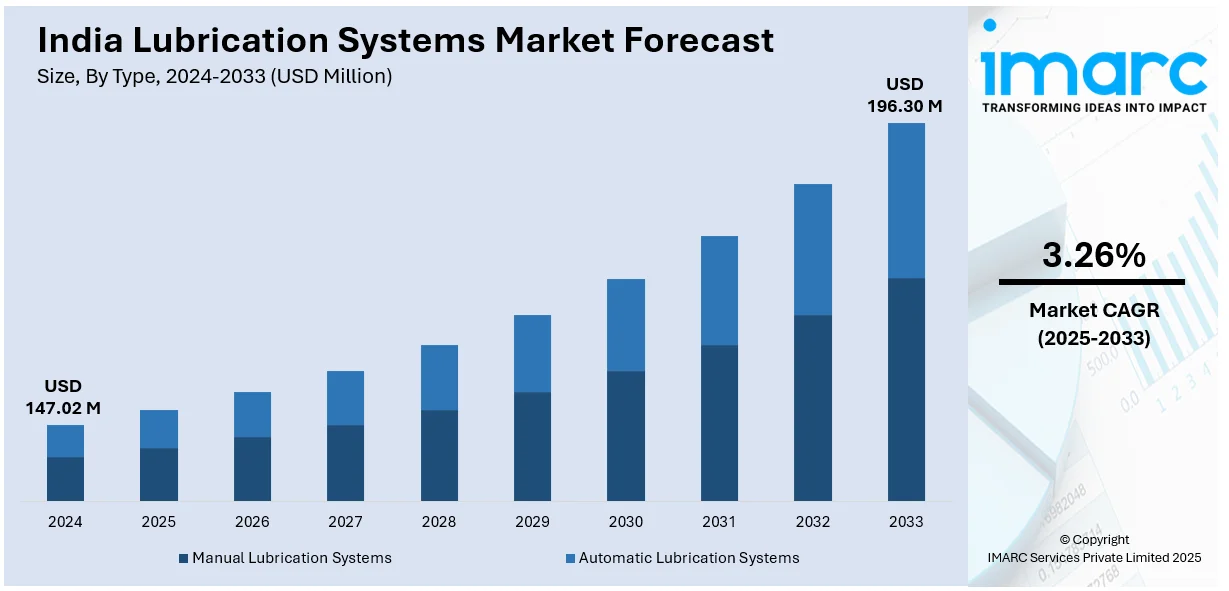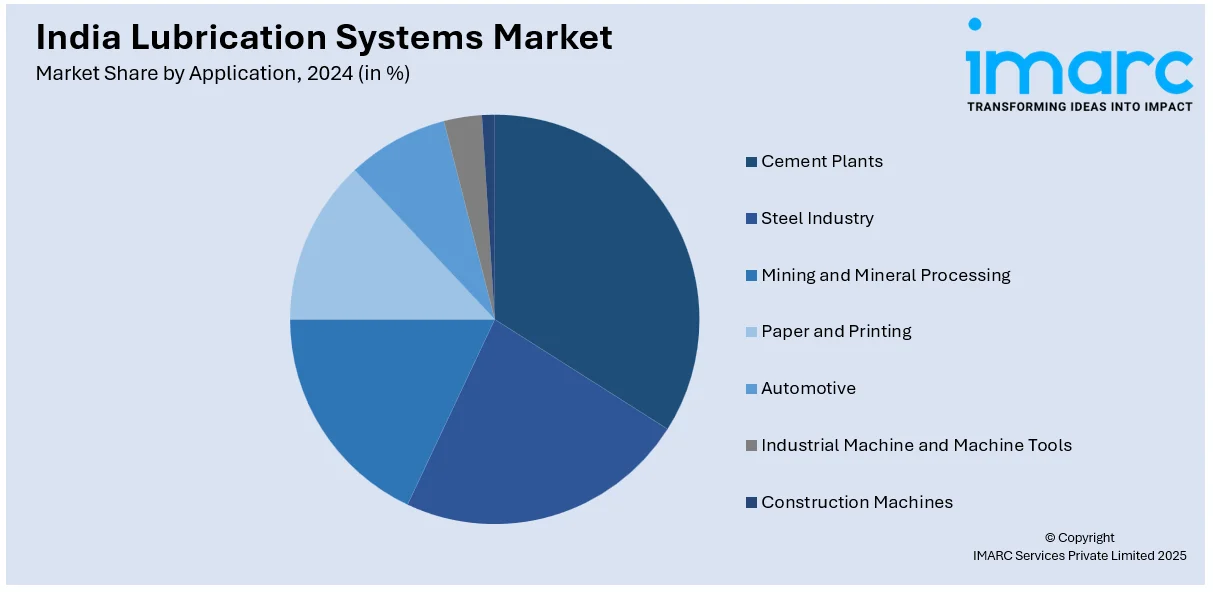
India Lubrication Systems Market Size, Share, Trends, and Forecast by Type, Application, Process, and Region, 2025-2033
India Lubrication Systems Market Overview:
The India lubrication systems market size reached USD 147.02 Million in 2024. Looking forward, IMARC Group expects the market to reach USD 196.30 Million by 2033, exhibiting a growth rate (CAGR) of 3.26% during 2025-2033. The market is witnessing growth due to growing demand for automated systems, technological advancements, and growing awareness of energy efficiency and environmental sustainability. Moreover, major industries, such as automotive, manufacturing, and construction are embracing these systems to enhance operational efficiency, lower maintenance expenses, and increase productivity.
|
Report Attribute
|
Key Statistics
|
|---|---|
|
Base Year
|
2024 |
|
Forecast Years
|
2025-2033
|
|
Historical Years
|
2019-2024
|
| Market Size in 2024 | USD 147.02 Million |
| Market Forecast in 2033 | USD 196.30 Million |
| Market Growth Rate 2025-2033 | 3.26% |
India Lubrication Systems Market Trends:
Growing Demand for Automated Lubrication Systems
The market for automated lubrication systems in India is progressively growing as businesses focus on enhancing operational efficiency and lowering maintenance expenses. Automated lubrication systems guarantee that machines are adequately lubricated without human involvement, which increases equipment life and productivity. Automotive, manufacturing, and construction industries are now more frequently incorporating these systems to minimize downtime, eliminate expensive repairs, and enhance safety levels. For instance, in August 2024, SKF announced the acquisition of John Sample Group's (JSG) Lubrication and Flow Management businesses. This acquisition enhances SKF's offerings in the growing lubrication management segment and strengthens its operations in India. Moreover, due to the requirement of precision and minimal human intervention, automated lubrication systems have a major edge over conventional manual techniques. This change towards automation is especially seen in mass industrial operations where maintenance of machinery is imperative for ensuring uninterrupted operations. In addition, automated systems guarantee the proper amount of lubricant at the right frequency, maximizing the use of resources and improving energy efficiency. As Indian industries shift towards Industry 4.0, the implementation of automated systems is likely to increase considerably due to technological innovation and the requirement for higher operational reliability.

To get more information on this market, Request Sample
Rising Awareness of Energy Efficiency and Environmental Impact
There is a growing emphasis on environmental sustainability and energy efficiency in India's lubrication systems market. With industries increasingly aware of their environmental impact, there is rising demand for environment-friendly lubricants and systems with low waste and emissions. Energy-efficient lubrication solutions reduce friction, which, in turn, reduces energy consumption. The Indian government's initiative towards sustainability, along with regulatory actions for minimizing carbon footprints, is fueling the use of green technologies in various industries. For instance, in May 2023, Government of India (GOI) introduced a draft RRBO EPR guidelines, reducing the initial 10% target to 5% RRBO content in lubricants. Moreover, this trend is highly evident in the manufacturing and automotive industries, where fuel-efficient equipment is paramount for saving costs as well as adhering to environmental standards. Furthermore, the introduction of biodegradable and bio-based lubricants is gaining traction, minimizing the impact on the environment provided by conventional petroleum-derived lubricants. With increasingly stringent environmental laws, industries will increasingly adopt energy-saving and green lubrication technologies that are in line with worldwide sustainability objectives.
India Lubrication Systems Market Segmentation:
IMARC Group provides an analysis of the key trends in each segment of the market, along with forecasts at the region level for 2025-2033. Our report has categorized the market based on type, application, and process.
Type Insights:
- Manual Lubrication Systems
- Automatic Lubrication Systems
- Single-line Lubrication Systems
- Dual-line Lubrication Systems
- Multi-line Lubrication Systems
- Series Progressive
- Circulating Oil
- Oil and Air
The report has provided a detailed breakup and analysis of the market based on the type. This includes manual lubrication systems and automatic lubrication systems (single-line lubrication systems, dual-line lubrication systems, multi-line lubrication systems, series progressive, circulating oil, and oil and air).
Application Insights:

- Cement Plants
- Steel Industry
- Mining and Mineral Processing
- Paper and Printing
- Automotive
- Industrial Machine and Machine Tools
- Construction Machines
A detailed breakup and analysis of the market based on the application have also been provided in the report. This includes cement plants, steel industry, mining and mineral processing, paper and printing, automotive, industrial machine and machine tools, and construction machines.
Process Insights:
- Dry Sump Lubrication
- Wet Sump Lubrication
The report has provided a detailed breakup and analysis of the market based on the process. This includes dry sump lubrication and wet sump lubrication.
Regional Insights:
- North India
- South India
- East India
- West India
The report has also provided a comprehensive analysis of all the major regional markets, which include North India, South India, East India, and West India.
Competitive Landscape:
The market research report has also provided a comprehensive analysis of the competitive landscape. Competitive analysis such as market structure, key player positioning, top winning strategies, competitive dashboard, and company evaluation quadrant has been covered in the report. Also, detailed profiles of all major companies have been provided.
India Lubrication Systems Market News:
- In March 2024, ExxonMobil announced an investment of ₹900 crore to establish a lubricants production plant in Maharashtra, expected to be operational by 2025. This investment will boost domestic production, reduce imports, and create 1,200 jobs, supporting the "Make in India" initiative.
- In August 2024, Lube Automatic Systems, a subsidiary of Lube Corporation, Japan, announced opening of a new corporate office in Vasai, Mumbai. The office aims to strengthen its operations in India, enhancing its role as the sole distributor of centralized lubrication systems for machine tools and plastic injection molding.
India Lubrication Systems Market Report Coverage:
| Report Features | Details |
|---|---|
| Base Year of the Analysis | 2024 |
| Historical Period | 2019-2024 |
| Forecast Period | 2025-2033 |
| Units | Million USD |
| Scope of the Report | Exploration of Historical Trends and Market Outlook, Industry Catalysts and Challenges, Segment-Wise Historical and Future Market Assessment:
|
| Types Covered |
|
| Applications Covered | Cement Plants, Steel Industry, Mining and Mineral Processing, Paper and Printing, Automotive, Industrial Machine and Machine Tools, Construction Machines |
| Processes Covered | Dry Sump Lubrication, Wet Sump Lubrication |
| Regions Covered | North India, South India, East India, West India |
| Customization Scope | 10% Free Customization |
| Post-Sale Analyst Support | 10-12 Weeks |
| Delivery Format | PDF and Excel through Email (We can also provide the editable version of the report in PPT/Word format on special request) |
Key Questions Answered in This Report:
- How has the India lubrication systems market performed so far and how will it perform in the coming years?
- What is the breakup of the India lubrication systems market on the basis of type?
- What is the breakup of the India lubrication systems market on the basis of application?
- What is the breakup of the India lubrication systems market on the basis of process?
- What is the breakup of the India lubrication systems market on the basis of region?
- What are the various stages in the value chain of the India lubrication systems market?
- What are the key driving factors and challenges in the India lubrication systems market?
- What is the structure of the India lubrication systems market and who are the key players?
- What is the degree of competition in the India lubrication systems market?
Key Benefits for Stakeholders:
- IMARC’s industry report offers a comprehensive quantitative analysis of various market segments, historical and current market trends, market forecasts, and dynamics of the India lubrication systems market from 2019-2033.
- The research report provides the latest information on the market drivers, challenges, and opportunities in the India lubrication systems market.
- Porter's five forces analysis assist stakeholders in assessing the impact of new entrants, competitive rivalry, supplier power, buyer power, and the threat of substitution. It helps stakeholders to analyze the level of competition within the India lubrication systems industry and its attractiveness.
- Competitive landscape allows stakeholders to understand their competitive environment and provides an insight into the current positions of key players in the market.
Need more help?
- Speak to our experienced analysts for insights on the current market scenarios.
- Include additional segments and countries to customize the report as per your requirement.
- Gain an unparalleled competitive advantage in your domain by understanding how to utilize the report and positively impacting your operations and revenue.
- For further assistance, please connect with our analysts.
 Request Customization
Request Customization
 Speak to an Analyst
Speak to an Analyst
 Request Brochure
Request Brochure
 Inquire Before Buying
Inquire Before Buying




.webp)




.webp)












